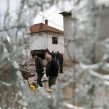
Russian Analyst Calls on Government to Learn From Recent Unrest in Macedonia
Publication: Eurasia Daily Monitor Volume: 12 Issue: 103
By:

Researchers have compared the North Caucasus and the Balkans as regions with similar historical and political trajectories (see for example Janusz Bugajski, Conflict Zones: North Caucasus and Western Balkans Compared, The Jamestown Foundation, 2014). This view has also gained traction among Russian experts. With the Russian government’s capacity projected to diminish over the next few years due to economic sanctions and other economic and political challenges, Russian experts have become preoccupied with forecasting the possible crumbling of state power in the North Caucasus (Kavkazskaya Politika, April 8).
Some Russian experts suggest that the recent flare-up of instability in the Balkans, specifically in Macedonia, may hold important lessons for Russian policy-makers vis-à-vis the North Caucasus. The deputy editor of the authoritative Russian journal Ekspert Yug, Nikolai Protsenko, noted that Macedonia and the North Caucasus republics, especially Kabardino-Balkaria and Karachaevo-Cherkessia, are quite similar to one another. One of the common features is that Islam and Christianity are quite visible in both places. The difference is that Christians and Slavs comprise a majority in Macedonia but are a minority in both Kabardino-Balkaria and Karachaevo-Cherkessia. Economic indicators in these two North Caucasus republics are quite similar to those in Macedonia. For example, the per capita GDP in the North Caucasus republics is estimated to be just over $4,000, while in Macedonia it is about $3,500. Both areas have high unemployment, although Macedonia’s whopping unemployment rate of 28.5 percent is comparable to Chechnya and Ingushetia, according to Protsenko (Kavkazskaya Politika, May 24).
One of the primary challenges Macedonia faces is the absence of an overarching political identity, since it has an ethnically and religiously diverse population, with two-thirds of it being Slavic and Christian and the other third being ethnic Albanian and Muslim. Some North Caucasus republics, such as Kabardino-Balkaria, Karachaevo-Cherkessia and Dagestan, face the same challenge of molding a republican identity to accommodate a diverse population. Contemporary Macedonia has identified Alexander the Great as the centerpiece of its national identity, even though Alexander the Great lived centuries before the Slavs entered the area that was ancient Macedonia. In the North Caucasus, several ethnic groups claim the ancient Alans as their ancestors and trace their history to ancient times (Kavkazskaya Politika, May 24).
The situation in Macedonia unexpectedly spiraled into violence in April 2015, when several police officers and suspected rebels were killed in clashes. The situation is aggravated by allegations against Prime Minister Nikola Gruevski concerning abuse of power. Since Gruevski came to power in the small Balkan country in 2006, Macedonia’s political freedoms indicators have steadily declined. At the same time, as some observers note, [t]he country’s economy “remains afloat through a sharp and unsustainable rise in borrowing” (Foreign Affairs, May 10). Unsustainable borrowing is another aspect that Macedonia and the North Caucasus share, except the North Caucasus’ debt mostly comes from Russian private borrowers and Russian government corporations. The North Caucasus also has access to politically driven subsidies from Moscow, in the form of hundreds of unpaid utility bills for such things as gas and electricity. The estimated backlog of payments for electricity alone was about $500 million as of the end of 2014 (Expert.ru, December 22, 2014). The Russian government has used discounts for energy supplies as a political tool to gain control over the countries of the former Soviet Union and beyond. The backlog of payments in the North Caucasus is apparently meant also to be a political tool to keep the region under Moscow’s control.
Along with the similarities between Macedonia and some North Caucasian republics, there are notable differences, most of which are not in favor of the North Caucasus. Macedonia has achieved far greater success in developing tourism and agriculture than the North Caucasus. Ironically, Moscow has specifically targeted these two areas of development in the North Caucasus, but has largely failed to improve either sector. Moreover, unlike the North Caucasus, Macedonia has made significant progress in improving the conditions for doing business. Macedonia is an independent state, which allows it to determine its domestic and foreign policy, while the North Caucasus has been under the personal control of Russia’s strongman, Vladimir Putin, for the past 15 years.
Yet, despite all of Macedonia’s progress, it still resembles the North Caucasus republics in crucial ways, in particular the uncertainty involving inter-ethnic relations. Observers note that the Macedonian government may now be using inter-ethnic tensions to remain in power, something that is quite familiar in the North Caucasus, except that in Russia, it is usually not the republican governments that try to use inter-ethnic tensions for their own purposes. Rather it is the central government in Moscow, and its neo-imperial elite, which has the capacity and the “know-how” to use tensions between competing ethnic groups to remain in control of the situation and manipulate one group against the other. The parallels between the Balkans and the North Caucasus are indeed striking and provide numerous facts for comparative analysis of the two areas, but except for one or two analysts in the West, these parallels are only now starting to be examined in greater detail.




